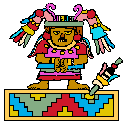 A map shows the various dialects that were spoken in what is now the state of Oaxaca at the time of the Spanish Conquest.
A map shows the various dialects that were spoken in what is now the state of Oaxaca at the time of the Spanish Conquest.The earliest known human occupation of the coast of Oaxaca was during the middle or late Preclassic period (before Christ). It appears that there were Mayan and Zapotecan influences. Later, Mixtec influences became dominant. The region was never conquered by the Aztec.
In the fourth century, according to legend, a group of Chichimecs traveled from the Valley of Mexico to the coast of Jalisco and sailed to Huatulco. They settled in various places and eventually traveled across the isthmus to the Gulf coast and established a government in Tututepec.
At the time of the Spanish conquest (1519-1522) the region was under the control of the lord of Tututepec. It is believed that the population descended from Chichimecs and spoke a Nahuatl dialect. They fished and grew cotton, corn, beans, squash, chile, chia, and sweet potatoes. Salt was made from seawater. Some gold was found.
 A map shows the various dialects that were spoken in what is now the state of Oaxaca at the time of the Spanish Conquest.
A map shows the various dialects that were spoken in what is now the state of Oaxaca at the time of the Spanish Conquest.
The local religion was Yzpapalotl, which included making offerings of birds, animals, and human blood and hearts. Victims were eaten.
Warriors used clubs with obsidian blades, bow and arrow, shields, and wore thick cotton clothing for protection.
Pochutla and its neighboring villages had a population of 8000 at the time of the conquest. In 1580 there were only about 20 families remaining due to illnesses and plagues. Prior to the Conquest, religious leaders also tended to be the medical specialists. The conquistadors actively suppressed the native religions in favor of their own and it is thought that this was a contributing factor to the great loss of lives to illness during this time.
Huatulco served as the major port for trade between New Spain and Peru from 1540 to 1560. This function later shifted to Acapulco. Huatulco fell prey to pirate attacks including those by Francis Drake in 1579 and Thomas Cavendish in 1587 (see Santa María Huatulco ). In 1616, the Spanish destroyed the port on orders from the Viceroy and development was evidently discouraged due to pirate attacks.
Although Puerto Angel was a settlement at this time, it was not considered desirable by the Spaniards due to the lack of an adequate water supply, a condition that persists in modern times.
Much of this early information comes from a survey of the geography, sociology and economy of the region performed by the Spaniards which was collected in the Relaciones Geográficas in 1580. There is also a letter written in 1522 by Hernando Cortes describing Pedro de Alvarado's conquest of Tututepec.
By the late 1700's the population of the Pochutla area had increased to only 1040.
In the mid-1800's the area saw military activity as armies marched toward Oaxaca City. Felix Diaz, a younger brother of Porfirio Diaz, was killed while trying to sail from Puerto Angel.
Puerto Escondido was founded as a coffee exportation center in 1925. The population reached 3000 in 1965 and is more than 30,000 today.
In 1930, Aldous Huxley entered Mexico at Puerto Angel. He described the town as consisting of four huts and two houses. In his book, Beyond the Mexique Bay, he noted that the port was being used for shipping and that coffee plantations were being established in the area.
In 1960, the concrete pier was built in Puerto Angel for the purpose of loading coffee onto smaller boats to transfer to freighters anchored at the entrance to the harbor. The coastal highway had not yet reached Puerto Angel, but work began about this time. The population of Puerto Angel grew to about 700 in 1965 and is about 12,000 today.
Much of this information comes from "The Archaeological Sequence from Sipolite, Oaxaca, Mexico," a thesis by D. L. Brockington, 1966.
![]()
A collection of newsgroup postings on sound phenomena in ancient
Mexican ballcourts and piramids.
See also Archaeology of the Region.
See also Dances from the Oaxacan Coast.